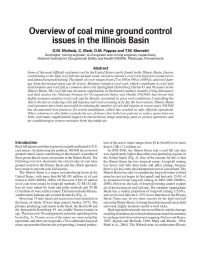Mining Publication: Overview of Coal Mine Ground Control Issues in the Illinois Basin
Original creation date: December 2008
Authors: GM Molinda, C Mark, DM Pappas, TM Klemetti
NIOSHTIC2 Number: 20034904
Trans Soc Min Metall Explor 2008 Dec; 324:41-48
Some of the most difficult coal mine roof in the U.S. can be found in the Illinois Basin. Factors contributing to the high roof fall rate include: weak moisture-sensitive roof rock, high horizontal stress, and limited longwall mining. The depth of cover ranges from 90-1,000 ft and roof damage from horizontal stress can be severe. Moisture sensitive-roof rock is common above the Springfield-Harrisburg Herrin #5 and #6 seams in the Illinois Basin, and contributes to roof skin deterioration. The roof fall rate increases significantly in the humid summer months. The National Institute for Occupational Safety and Health (NIOSH) has shown, using lab and field studies, that highly moisture-sensitive roof rock can be directly correlated to poor roof conditions. Controlling the skin is the key to reducing rock fall injuries, and roof screening is, by far, the best remedy. Illinois Basin coal operators have been successful in reducing the number of rock fall injuries in recent years. NIOSH has documented best practices for screen installation which has resulted in safe, efficient operations. Other solutions to skin failure include: the use of denser five bolts per row patterns to reduce spans between bolts, systematic supplemental support in intersections, straps and large pans protecting operators, and air conditioning to remove moisture from the intake air.

NIOSHTIC2 Number: 20034904
Trans Soc Min Metall Explor 2008 Dec; 324:41-48
- Creep Along Weak Planes in Roof and How It Affects Stability
- Development and Application of the Coal Mine Roof Rating (CMRR)
- Diagnosing and Controlling Moisture-Sensitive Roof in Coal Mines
- The Introduction of Roof Bolting to U.S. Underground Coal Mines (1948-1960): A Cautionary Tale
- Mistakes, Misconceptions, and Key Points Regarding Secondary Roof Support Systems
- Optimizing Secondary Roof Support with the NIOSH Support Technology Optimization Program (STOP)
- Performance Characteristics for Welded Wire Screen Used for Surface Control in Underground Coal Mines
- Preventing Falls of Ground in Coal Mines With Exceptionally Low-Strength Roof: Two Case Studies
- Preventing Injuries Caused by Unrecognized Stone Mine Roof Beam Failures With a Pro-Active Roof Control Plan
- A Study of the Ground Control Effects of Mining Longwall Faces Into Open or Backfilled Entries